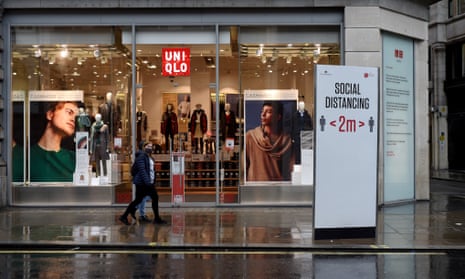The number of furloughed workers in the UK is expected to more than double this month to as many as 5.5 million as the government places England into national lockdown and expands its emergency Covid-19 wage support schemes.
Economists said businesses were set to claim for billions of pounds of additional state support from the furlough scheme over the coming weeks, amid the enforced closure of non-essential venues for the second time this year.
With pubs, restaurants and most shops in England due to close their doors for at least four weeks from Thursday, and with companies also struggling under the weight of measures in Scotland, Wales and Northern Ireland, the Institute for Employment Studies (IES) thinktank and the consultancy Capital Economics said up to 5.5 million people could be furloughed this month.
This would represent more than double the 2 million jobs still furloughed across the UK in October, with the new English lockdown expected to drag more companies into trouble to join the ranks of hospitality, leisure and arts businesses that have already been fighting to stay afloat for months under existing restrictions.
The IES and Capital Economics said the cost to the exchequer to subsidise the wages of up to 5 million workers for one month could be as much as £5bn, although the final sum would depend on how many companies used the extension and whether businesses took advantage of rules allowing its flexible part-time usage. The newly extended furlough scheme, scheduled to last one month, will cover up to 80% of the wages of a temporarily laid-off worker.
A £5bn price tag would take the overall cost of furlough to about £54.5bn by the end of the year, roughly the same as the defence budget.
Boris Johnson has suggested the furlough scheme could be used beyond November by devolved administrations in Scotland, Wales and Northern Ireland.
Asked whether furlough would be extended in other parts of the UK if needed after England’s lockdown ends in December, the prime minister said: “The furlough scheme is a UK wide scheme. If other parts of the UK decide to go into measures which require the furlough scheme then of course it is available to them, that has to be right. That applies not just now but in the future as well.”
As many as 8.9 million people were furloughed at the peak of the scheme in May. But the second lockdown is not expected to be as stringent as the first, with schools staying open and sectors such as manufacturing and construction and the property market expected to continue operating.
Ruth Gregory, the senior UK economist at Capital Economics, said this meant fewer jobs would be furloughed than during the first nationwide shutdown. She said 5.5 million was an upper estimate because many companies had already made job cuts and were now more adept at remote working. But she said a sharp rise was to be expected as many businesses would be forced to close entirely.
“If we learned anything from the spring, it is that firms did not hesitate to place workers on to the furlough scheme,” she said.
The expected rise in furloughing this month comes as Britain’s economic recovery from the first lockdown is dramatically blown off course. The National Institute for Economic and Social Research said the announcement of a further shutdown in November and rapid growth in Covid infections would tip the economy back into contraction in the final three months of the year.
Downgrading its forecast for fourth-quarter GDP growth from 1.5% to a fall of 3.3%, the thinktank said the second wave, tougher restrictions and Brexit posed a significant threat to Britain’s economic recovery from the pandemic. It said the extension of furlough would probably help to prevent a sharp rise in job losses before the end of 2020, but that joblessness would still remain elevated over the coming years, exacerbated by the prospect of a long and uncertain route to economic recovery.
After the one-month reprieve, the government plans to launch a less generous job support scheme in December, which pays two-thirds of wages, rather than 80%, and comes with tougher eligibility criteria. Sonali Punhani, an analyst at the Swiss bank Credit Suisse, said reducing the safety net would mean driving up unemployment to 6.5% by the end of the year from the current 4.5%.
“This implies the UK runs the risk of a slower rebound next year compared to the third quarter of 2020, unless generous job support is extended beyond the lockdown. Brexit is likely to weigh on the recovery too,” she said.
